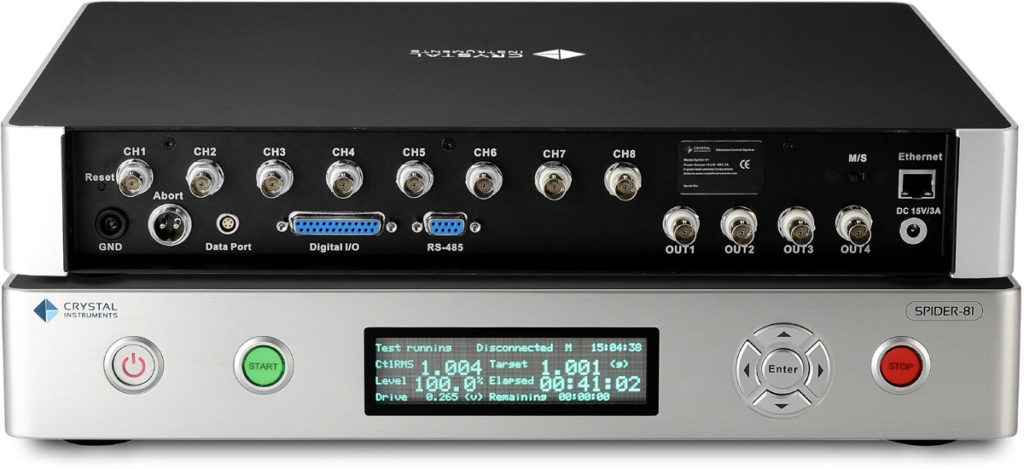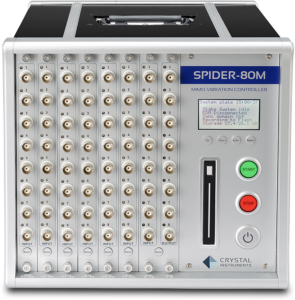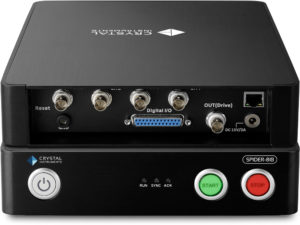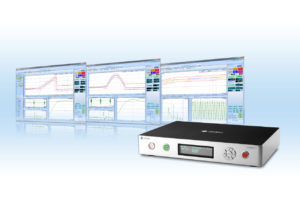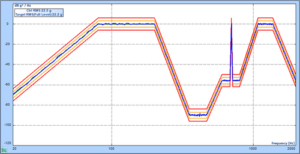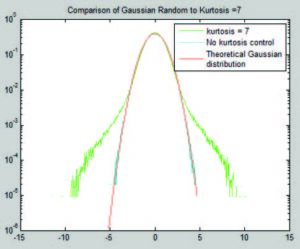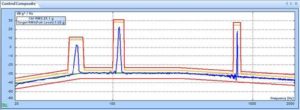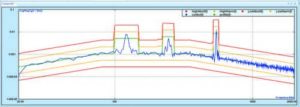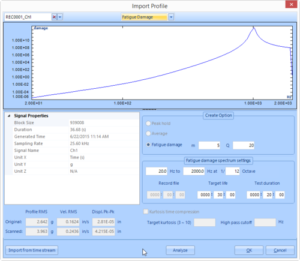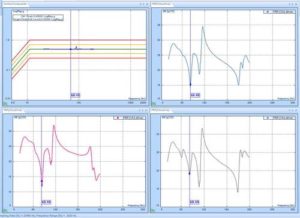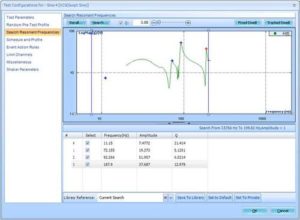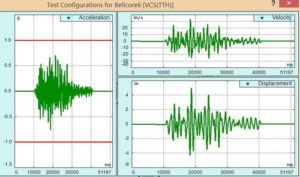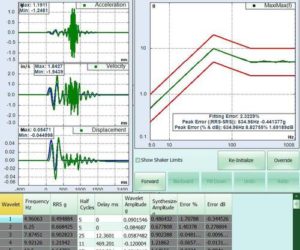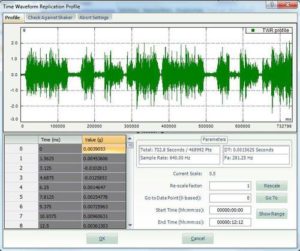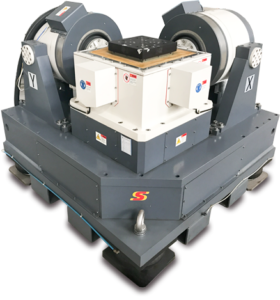Schwingregelsysteme Spider-81
Vibration Control Systeme zur Ansteuerung von Shakern.
Einsatz als PC- Frontend oder im autonomen Black Box Modus.
Übersicht
Diese Vibration Control Systeme erzeugen eine Vielzahl von Ausgangssignalen zur rückgekoppelten Ansteuerung von Schwingprüfsystemen / Shakern und erfassen gleichzeitig bis zu 512 Messsignale.
Die zeitkritische Signalverarbeitung erfolgt bei den Spider-81 Systemen mit integrierter DSP Technologie. Im Gegensatz zu PC-basierenden Systemen wird hiermit eine höhere Verarbeitungsleistung, Zuverlässigkeit und Betriebssicherheit erreicht. Darüber hinaus lassen sich größere Kanalzahlen realisieren, ohne die Systemleistung zu beeinträchtigen.
Die Ethernet Schnittstelle erlaubt den Betrieb der Systeme in großer Entfernung vom jeweiligen Host PC, jedoch nah an der Schwingprüfanlage. Dies erfordert nur kurze analoge Leitungen und reduziert externe Signaleinflüsse auf die Ein- und Ausgangssignale.
Die Spider-81 Systeme lassen sich vom PC aus steuern, verfügen jedoch auch über einen autonomen Black Box Modus in dem der Controller selbstständig den voreingestellten Testablauf abarbeitet.
Die Bedienung der EDM VCS Software wird durch grafische Anleitungen und Assistenten erleichtert und durch eine intuitive, logische Anordnung der Bedienelemente vereinfacht. Ereignisgesteuerte Aktionen lassen sich konfigurieren und Abbruchbedingungen definieren; Suchbegriffe erleichtern das Auffinden und Verwalten umfangreicher Testdateien.
Die Serie besteht aus verschiedenen Modellen und Erweiterungs-Modulen sowie einer modularen Software, die alle gängigen Aufgabenstellungen abdeckt.
Aktuell
Besondere Merkmale
- Rückgekoppelte Steuerung von Schwingprüfsystemen / Shakern
- Signalverarbeitung durch integrierten DSP für höchste Verarbeitungsleistung, Zuverlässigkeit und Betriebssicherheit
- Ethernet-Anbindung über bis zu 100 m
- Alle marktüblichen Steuerungsfunktionen
- Autonomer Black Box Modus
- Bis zu 512 Eingangskanäle ohne Beeinträchtigung der Systemleistung
- Recording von Zeitsignalen im internen 4 GB Flash-Speicher, optional im NAS mit 256 GB bis 2 TB
- Reporterstellung und Export nach UFF, Matlab …
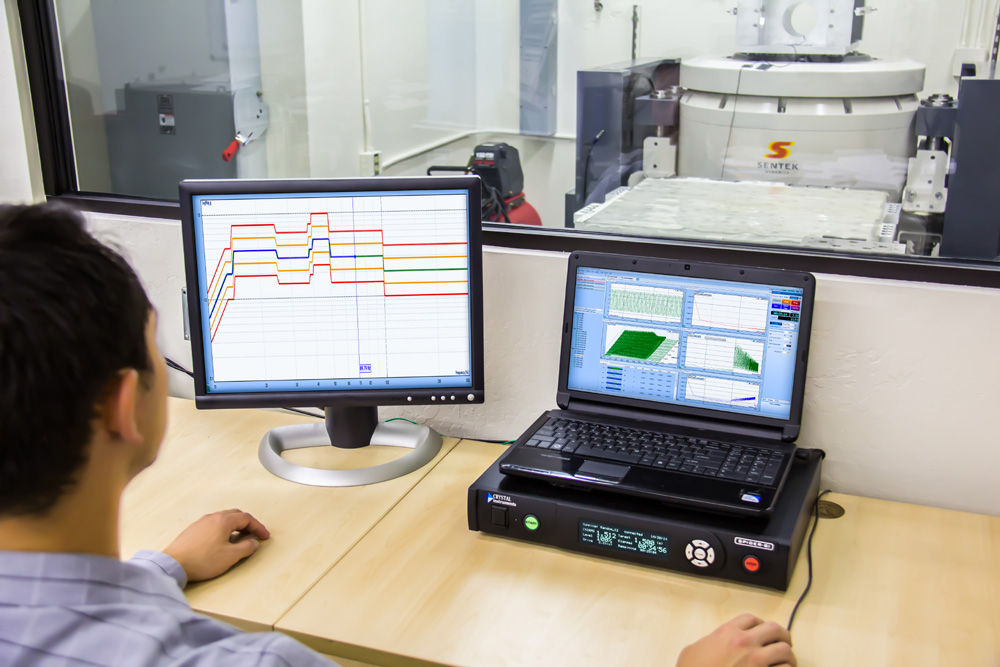
Modelle
Spider-81
Spider-81 ist der Premium-Controller mit 4, 6 oder 8 Eingangskanälen und 2 Ausgangskanälen. Ein LCD Monitor zeigt die relevanten Test-Informationen an und erlaubt das Laden und Steuern von bis zu 8 Testkonfigurationen im PC-losen Black Box Mode. Über 10 Monitor-Kanäle lassen sich Ein- und Ausgangssignale überwachen; digitale I/Os sowie eine RS-485 Schnittstelle ermöglichen die Anbindung an externe Hardware. Über einen Not-Aus-Anschluss lässt sich ein Test im Falle einer Störung sofort geordnet herunterfahren.
Die Spider-81 Controller lassen sich mit allen Spider-80 Modulen und Karten auf Systeme mit bis zu 512 Eingängen und 6 Ausgängen erweitern.
Spider-81B
Das Spider-81B Schwingregelsystem wurde für als preisgünstige Alternative für einfachere Aufgabenstellungen mit nur wenigen Kanälen entwickelt.
Es besitzt 2 oder 4 Eingänge, 1 Ausgang und je 4 digitale I/Os.
Eine Synchronisierung mehrerer Controller ist hier nicht vorgesehen.
Downloads
- Spider VCS MIMO Präsentation in englisch
- Spider VCS MIMO Software Specs in englisch
- VCS: Automation Features
- VCS: Communication with external Devices & Applications
- Release Notes (All) der EDM Version 11.0 in englisch
- Release Notes (All) der EDM Version 11.1 in englisch
- Release Notes (All) der aktuellen EDM Version 12.0 in englisch
Weitere Infos:
Spider-HUB
Der Spider-HUB ist ein Ethernet-Switch mit 10 Ports zur Synchronisierung von bis zu acht Spider-80X oder Spider-80SG Modulen. Er verwendet die neueste IEEE 1588v2 Technologie, um eine Synchronität zwischen den Modulen innerhalb 50 ns zu garantieren.
Spider-NAS
Das Spider-NAS Speichermodul verfügt über 8 High-Speed Daten-Eingänge, welche direkt mit den entsprechenden Ausgängen der Spider-80 Module verbunden werden. Zusätzlich ist eine Ethernet Schnittstelle zur Konfiguration und Steuerung des NAS enthalten.
Eine wechselbare SATA 2,5″ Solid State Disk mit 256 GB Kapazität ist im Lieferumfang enthalten. Sie ermöglicht die Erfassung aller (max. 64) Kanäle der anschließbaren Spider-80 Module mit jeweils 100 kS/s Abtastrate. Der Anschluss eigener 2,5″ SSDs und HDDs ist möglich.
Spider-BATTERY
Die Spider-BATTERY ist ein Modul mit einem wiederaufladbaren Akku mit 13 Ah Kapazität. Sie kann verwendet, um ein Spider-80 System für eine begrenzte Dauer ohne externe Versorgungsspannung zu betreiben oder Ausfälle der externen Versorgungsspannung zu überbrücken.
Die zu den Schwingregelsystemen der Spider-81 Serie gehörige VCS (Vibration Controller System) Version der EDM-Software wurde für eine Vielzahl von Anwendungen im Bereich von Schock- und Vibrations-Tests entwickelt. Editierbare Vorlagen ermöglichen das Erstellen von Berichten in XML, OpenOffice, PDF oder Microsoft Word mit nur einem Klick.
Die EDM Programme unterstützen Systeme mit 2 bis 512 Eingangskanälen und mehreren Ausgangskanälen. Die Funktionen umfassen u.a.:
- Random Vibration Control mit den Optionen
– Kurtosis Control
– Sine on Random (SoR) Control
– Random on Random (RoR) Control
– Fatigue Damage Spectrum - Swept Sine Control mit den Optionen
– Resonance Search Track & Dwell (RSTD)
– Multi Sine Control - Classical Shock Control mit den Optionen
– Transient Time History (TTH) Control
– Shock Response Spectrum (SRS) Synthesis and Control
– Transient Random Control
– Earthquake Testing Control - Time Waveform Replication (TWR)
Random Vibration Control
The Random Vibration Control System provides precise, real-time, multi-channel control and analysis. Random supports up to 512 input channels. Users can enable up to 128 channels for control and notching. Users can designate the rest of the channels as monitoring and time data recording channels. The recording option records time stream data at a full sample rate on all input channels. A unique hardware design provides a fast loop time of less than 15 ms. An optional Kurtosis control can create a non-Gaussian random signal.
Notching and Limiting for Random is applied to control or monitor channels. Three types of limiting are available in Random Control: frequency domain, time domain, and advanced limit.
Multi-resolution control provides two different frequency resolution controls in the same Random control test. The multi-resolution control algorithm enhances the spectral resolution to eight times in the low frequency range which provides much higher control accuracy in the low frequency range.
NEU: Multi-Resolution Spectral Analysis sorgt für 8-fach höhere Auflösung im unteren Frequenzbereich
Kurtosis Control
Kurtosis is a measure of the frequency of occurrences of large peaks in a waveform. Kurtosis control allows the user to specify the target kurtosis of the random control signal, and the controller will adjust the amplitude distribution of the vibration to match the target. This is done with minimal effect on the frequency content and dynamic range. Possible kurtosis values are 3 – 10. Supports up to 512 input channels.
Sine on Random Control
Sweeping Modes: free sweeping mode where each sine tone has their own schedule and sweeping speed, and harmonic mode where the first tone controls the sweeping speed. Number of Sine Tones: 1 – 12 in free-sweeping mode; 1 – 20 in harmonic mode, up to 32 when RoR is disabled. Operation Controls: Tone On and Tone Off controlled by run schedule, external events, or user commands. Supports up to 512 input channels.
Random on Random Control
Sweeping Mode: free sweeping mode where each narrow random band has its own schedule and sweeping speed. Number of Bands: 1 – 12, up to 32 when SoR is disabled. Operation Controls: Band On and Band Off controlled by run schedule, external events or user commands. Supports up to 512 input channels.
Fatigue Damage Spectrum
Generate the random profile from time stream data recorded in real-world and see its Fatigue Damage Spectrum (FDS) to know the potential damage. Users can adjust the profile to reduce testing time.
Swept Sine Control
The Swept Sine Vibration Control provides precise, real-time, multi-channel control using sine waveform. Swept Sine supports up to 512 input channels. Users can enable up to 128 channels for control and notching while designating the remaining as monitoring and time data recording channels. The recording option records time stream data at the full sample rate on all input channels, regardless of the total channel number. A unique hardware design provides a fast loop time of less than 10 ms. Black Box mode allows a user to operate the controller without a PC.
Step Sine uses a sequence of short dwells within a frequency range. The steps are uniformly distributed in a log or linear frequency scale.
Total Harmonics Distortion (THD) Measurement adds the ability of computing the Total Harmonics Distortion (THD) of the control and input signals. It is available in both Step Sine and Swept Sine.
Notching and Limiting is applied to control or monitor channels. Three types of limiting are available in Sine Control: frequency domain, time domain, and advanced Limit. Two types of limiting are available in Multi-sine control: frequency domain and time domain.
Resonance Search and Tracked Dwell (RSTD) Control
The search function determines the resonant frequencies using a transmissibility signal between input channels on the master front-end. In real-time control, the tracked dwell entry tracks each resonant frequency. Dwell entries (fixed dwell, tracked dwell, phase tracked dwell) are added manually or automatically after a sweep entry is done or the list of resonances is determined. Supports up to 512 input channels.
Multi-Sine Control
Multi-Sine Control enables the simultaneous sweeping of multiple sine tones and ensures the option to excite multiple resonant frequencies of the structure. With multiple sine tone excitation, the required time duration of sine testing can reduce significantly. Independent tracking filters are applied to each tone separately.
Classic Shock Control
The Classic Shock Vibration Control provides precise, real-time, multi-channel control and analysis for transient time domain control. Up to 8 channels are enabled for control, alarm checking, and time data recording on master module. Up to 511 channels are enabled for monitoring and time data recording. Classical pulse types include half-sine, haver-sine, terminal-peak sawtooth, initial-peak saw tooth, triangle, rectangle, and trapezoid. The Transient Time History Control option is typically used for low frequency seismic testing. The recording option records time stream data at the full sample rate on all input channels. The shock response spectrum analysis can apply to any input signals. Black Box mode allows a user to run the controller without a PC.
Test Standards: MIL-STD-810G, MIL-STD-810H, MIL-STD-202F, ISO 8568, IEC 60068, User-defined
Transient Time History Control (TTH)
Using template based importing tools, time waveform in various formats are imported into EDM VCS. Scaling, editing, digital re-sampling, high-pass, low-pass filtering, and compensation will tailor the waveform and duplicate it on a shaker. Compensation methods include pre-pulse, post-pulse, DC removal and high-pass filters.
Pre-stored profiles include Bellcore Z1 & Z2, Bellcore Z3, Bellcore Z4, (Burst) Sine, Triangle, Chirp, Burst Chirp, White Noise (Burst Random), Sine Beat, Sine Beat (multiple frequency), Door Slam (Ford), Decay sine (linear/angular frequency), Sine Burst.
Shock Response Spectrum (SRS) Synthesis & Control
The SRS vibration control package provides controls to meet a target Required Response Spectrum (RRS). Waveforms are automatically synthesized from a user-specified SRS reference profile using sine wavelets. The Transient Control option allows control of imported transient files. Users can apply high frequency waveforms and alarm and abort tolerances to any active channel to provide an extra degree of safety for delicate test articles.
Transient Random Control
Transient Random Control drives a chain of pulses with random nature to the shaker. The target profile power spectrum is defined in the same way as Random control, with the addition of defining the transient pulse interval. Applications include simulation gunfire or road simulation. Supported by hardware versions 7.x and above and supports up to 512 input channels.
Earthquake Testing Control
The earthquake testing control package provides controls to meet a target a Required Response Spectrum (RRS). Waveforms are automatically synthesized from a user-specified SRS reference profile using random type of wavelets, uniform or shaped. Alarm and abort tolerances may be applied to any active channel to provide an extra degree of safety for delicate test articles.
Compliance: IEEE 344-2013
Time Waveform Replication
Time Waveform Replication (TWR) provides precise, real-time, multi-channel control for long waveform duplication. TWR is capable of running an unlimited number of time profiles in a defined schedule. Multiple long waveforms can duplicate precisely on the shaker just as they were recorded. It includes Waveform Editor (EDM-WE), a flexible importing and editing tool for long waveform signals. The recording option allows the recording of time stream data at the full sample rate on all input channels. Users can enable up to 8 channels for control and time data recording on the master front-end. Users can enable up to 511 channels for monitoring and time data recording.
General Options:
Sine Oscillator: A diagnosis tool with manual control to the sine output while the system displays various time signals and frequency spectra. Users can enable random excitation as a checkup function. Tracking filters are applied to each input channel to extract the signals at a sweeping frequency. When the close-loop option is enabled, the Sine Oscillator is essentially a limited sine controller with more manual control functions.
Non-Acceleration Control: With this option, users can apply a non-acceleration measurement quantity to the control signal. This provides an option of choosing from multiple quantities including force, sound, and voltage to be controlled when the appropriate sensors are used. Angular acceleration is controlled in Sine and Random tests using the appropriate selection. The controller is also capable of using mixed displacement, velocity and acceleration sensors to synthesize a control signal in the acceleration domain.
Multi-Master Option: Creates a special license key that allows multiple front-end systems to be split into several independent systems. Any front-end enabled with this license key can operate as a Master unit. Ordering this option will enable the same set of software running on each or any combination of the Spiders that are defined in this license key.
Multi-Shaker Control: EDM Multi-Shaker Control (MSC) is a software option included in the EDM testing package along with VCS. MSC provides one centralized interface to interact with multiple controllers running separate tests at the same time. Multi-shaker controllers are not time synchronized unlike in MIMO Control, in which all drives are time synchronized.
Sensor Calibration: The Sensor Calibration tool is used to calculate the sensitivity of sensors while the measurements of the sensors are compared against referenced sine wave input signals. The user enters the calibration signal nominal frequency, selects either RMS reading or dB RMS reading, and references the dB value. The front-end automatically calculates the RMS levels and updates the sensitivity table. The user accepts or rejects the calibration results and views the reports.
Spider Front-end Calibration Software: Each front-end is calibrated at the factory prior to shipping and should be recalibrated annually by the factory or a factory authorized calibration service. EDM Utility includes an optional stand-alone Front-End Calibration Tool (FECT) that is operable by either the user or a calibration specialist. Calibration data is stored inside of the Spider front-end.
Waveform Editor: Waveform Editor is a Windows application that allows the user to edit, cut, paste and scale a time waveform to be duplicated on the shaker. Users can import one or multiple channels of data for editing. It can also apply displacement compensation so that the resulting waveform is reproduced on a shaker using a Vibration Control System with Time Wave Replication (TWR) software.
CAN bus: CAN bus is the abbreviation for the Controller Area Network Bus which is a communication protocol allowing peer to peer (usually the microcontrollers and devices) communication without the host control. EDM integrates this feature to receive and record raw data from the CAN bus adapter, decipher the raw data to signals, and apply alarm and abort limits to those signals. The necessary/safety actions can be executed automatically when a CAN bus signal triggers its alarm or abort limits.
The Multiple-Input Multiple-Output (MIMO) Control System includes the following:
- MIMO Random Control
- MIMO Sine Control
- MIMO Classical Shock
- MIMO Transient Time Control
- MIMO Shock Response Spectrum (SRS)
- MIMO Time Waveform Replication (TWR) Control
and all typical applications used for environmental testing.
MIMO Random Vibration Control
The MIMO Random Control System provides precise, real-time, multi-channel control and analysis. MIMO Random supports up to 512 input channels, and up to 8 output chan-nels (shakers). After the control channels are designated, the remaining input channels can be set up as monitoring and time data recording channels. The recording option re-cords time stream data at the full sample rate on all input channels. A unique hardware design provides a fast loop time of less than 15 ms.
MIMO Sine Control
The MIMO Sine Control System provides precise, real-time, multi-channel control and analysis. MIMO Sine supports up to 512 input channels, and up to 8 output channels (shak-ers). Input channels can be enabled for control, monitoring, and time data recording channels. The recording option records time stream data at the full sample rate on all input channels, regardless of the total channel number. A unique hardware design provides a fast loop time of less than 10 ms.
MIMO Classic Shock Control
The MIMO Classic Shock Vibration Control provides precise, real-time, multiple shaker table control and analysis for transient time domain control. Up to 8 out-put channels (shaker) can be enabled for control with indi-vidual classical shock waveform defined for each control channel, alarm checking, and time data recording on mas-ter module. Up to 512 channels can be enabled for con-trolling/monitoring and time data recording. Classical pulse types include half-sine, haver-sine, terminal-peak saw-tooth, initial-peak saw tooth, triangle, rectangle, and trap-ezoid. The recording option records time stream data at the full sample rate on all input channels. Shock response spectrum analysis can be applied to any input signals.
Test Standards: MIL-STD-810F, MIL-STD-810G, MIL-STD-202F, ISO 9568, IEC 60068, user-defined
MIMO Transient Time History Control (TTH)
Using template based importing tools, time waveform in various formats are imported into EDM VCS. Scaling, editing, digital re-sampling, high-pass, low-pass filtering, and compensation will tailor the waveform and duplicate it on a shaker. Compensation methods include pre-pulse, post-pulse, DC removal and high-pass filters.
Pre-stored profiles include Bellcore Z1 & Z2, Bellcore Z3, Bellcore Z4, (Burst) Sine, Triangle, Chirp, Burst Chirp, White Noise (Burst Random), Sine Beat, Sine Beat (multiple frequency), Door Slam (Ford), Decay sine (linear/angular frequency), Sine Burst.
MIMO Shock Response Spectrum (SRS) Synthesis & Control
The SRS vibration control package provides controls to meet a target Required Response Spectrum (RRS). Waveforms are automatically synthesized from a user-specified SRS reference profile using sine wavelets. The Transient Control option allows control of imported transient files. Users can apply high frequency waveforms and alarm and abort tolerances to any active channel to provide an extra degree of safety for delicate test articles.
MIMO Time Waveform Replication
The MIMO Time Waveform Replication (TWR) Control System provides precise, real-time, multi-channel control for long waveform duplication. MIMO TWR is capable of running an unlimited number of time profiles in a defined schedule. Multiple long waveforms can be duplicated precisely on the shaker just as they were recorded. It includes Waveform Editor (EDM-WE), a flexible importing and editing tools for long waveform signals. The recording option allows the recording of time stream data at the full sample rate on all input channels. Up to 8 channels can be enabled for control and time data recording on master front-end. Up to 512 channels can be enabled for control or monitoring, and time data recording.
General Options:
Time Waveform Editor: Time Waveform Editor is a Windows application that allows the user to edit, cut, paste and scale a time waveform to be duplicated on the shaker. Users can import one or multiple channels of data for editing. It can also apply displacement compensation so that the resulting waveform is reproduced on a shaker using a Vibration Control System with Time Wave Replication (TWR) software.

